
How Symbolic AI Can Power Edge Devices in IoT Systems: Efficiency without Heavy Compute Needs
What is Symbolic AI?
Understanding the Basics of Symbolic AI
Symbolic AI is a branch of artificial intelligence that operates using rules, logic, and symbols to represent and process information.
Unlike machine learning, which relies on data-driven models, symbolic AI focuses on explicitly defined relationships and knowledge structures to make decisions.
It enables AI to process information without extensive computational resources, making it well-suited for applications where simplicity and precision are key.
Symbolic AI often incorporates knowledge graphs, rule-based systems, and logic inference. These techniques allow it to process knowledge in a structured way, making it especially relevant for IoT edge devices that need to make quick, efficient decisions based on predefined rules and relationships.
Differences Between Symbolic AI and Machine Learning
Symbolic AI contrasts sharply with machine learning and deep learning, which require vast amounts of data and compute power to train and operate. While machine learning is great for tasks requiring pattern recognition (like image processing), symbolic AI excels where rules-based decisions and clear hierarchies are important. Symbolic systems can make sense of data using fewer resources, allowing for efficient and transparent decision-making.
For edge devices, this efficiency means they can perform intelligent actions without relying on powerful central servers, making symbolic AI a game-changer for resource-constrained environments.
Why Symbolic AI is Ideal for IoT Edge Devices
Edge devices are frequently low-power devices with limited computational capabilities. Symbolic AI’s lightweight structure allows it to function effectively within these limitations, handling tasks like rule-based control, anomaly detection, and decision-making. By offloading some intelligence to edge devices, IoT systems can reduce latency, improve response times, and function even in low-connectivity settings, enhancing reliability and autonomy.
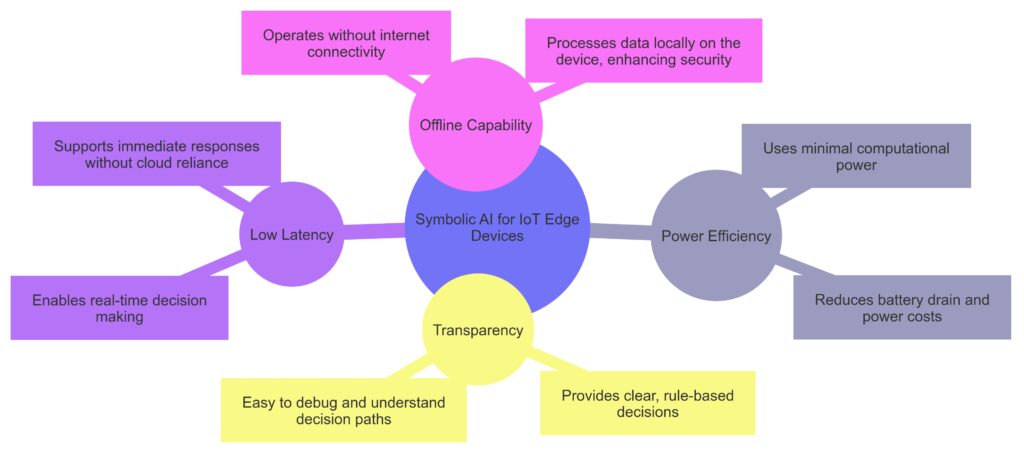
Power Efficiency: Uses minimal computational power, reducing battery drain and power costs.
Transparency: Provides explainable, rule-based decisions and is easy to debug.
Low Latency: Enables real-time, immediate responses without relying on the cloud.
Offline Capability: Operates effectively without internet connectivity and processes data locally, enhancing security.
These features make symbolic AI well-suited for resource-constrained IoT environments, ensuring efficient and responsive device operations.
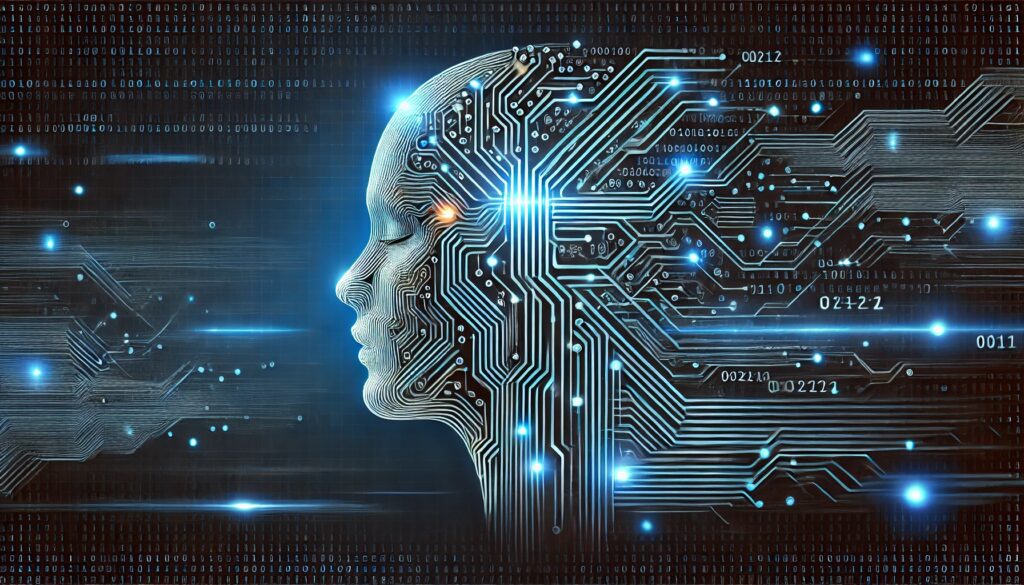
How Symbolic AI Enhances Efficiency in IoT Systems
Low Compute Requirements
Symbolic AI’s primary advantage is its low compute requirement. Unlike data-heavy models, symbolic AI doesn’t rely on vast memory or processing power. For IoT devices, which typically need to operate on minimal power, this efficiency means they can run AI models on-device without overwhelming the system. For example, a smart thermostat could use symbolic AI to recognize temperature rules and adjust without needing a constant cloud connection.
In IoT networks where numerous devices interact, symbolic reasoning at the edge reduces the need for centralized processing, freeing up network bandwidth and ensuring critical functions continue even if connectivity is interrupted.
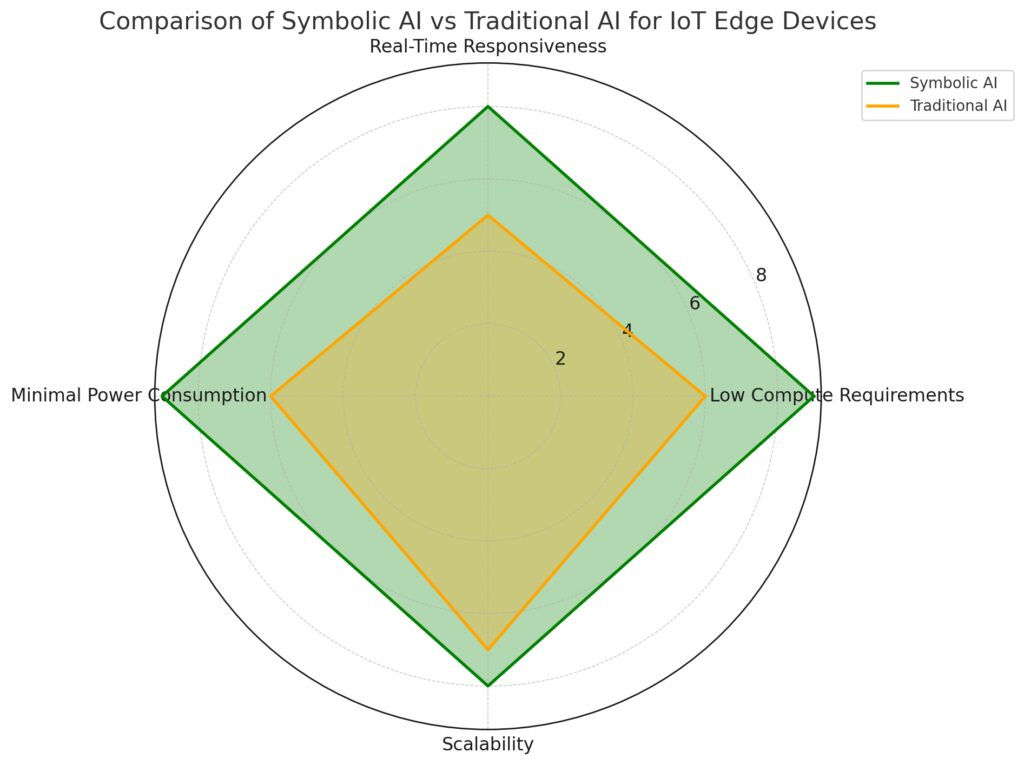
Low Compute Requirements and Minimal Power Consumption: Symbolic AI scores higher due to its lightweight processing needs, making it ideal for resource-constrained edge devices.
Real-Time Responsiveness: Symbolic AI provides faster response times for immediate decision-making, crucial for real-time applications.
Scalability: Both approaches are scalable, but Symbolic AI’s efficiency enhances its suitability for a wider range of IoT edge applications.
The green area represents Symbolic AI’s strengths, while the orange area shows traditional AI, highlighting Symbolic AI’s advantages across these critical dimensions for IoT applications.
Speed and Real-Time Responsiveness
Symbolic AI operates using a predefined set of rules, which enables faster decision-making because there is no need for complex data processing. Edge devices equipped with symbolic AI can instantly respond to inputs, making them ideal for real-time applications like monitoring systems, security cameras, and automated manufacturing.
This responsiveness is particularly useful in time-sensitive scenarios where milliseconds matter—for instance, a fire detection system in a building that needs to trigger an alarm immediately when smoke is detected. Symbolic AI enables such devices to make rapid, reliable decisions, ensuring they act quickly on critical tasks.
Minimal Power Consumption
Edge devices are often deployed in environments where power availability is limited—think remote sensors, wearable health devices, or smart agriculture systems. Symbolic AI’s lower power requirements allow these devices to perform intelligent functions without quickly draining their batteries. Unlike neural networks that require constant computational power, symbolic AI only needs enough to process simple logic or rule sets.
By enabling efficient, intelligent behavior at the edge, symbolic AI extends device battery life, which is a huge advantage for IoT applications deployed in remote or hard-to-reach areas where changing or recharging batteries is challenging.
Practical Applications of Symbolic AI in Edge IoT Systems
Smart Home Automation
In smart home environments, symbolic AI can streamline automation tasks without the need for high-powered processing. For instance, symbolic AI can control lighting, heating, or security by following simple rules based on input data like temperature, time, or occupancy status. This allows smart home systems to be more reliable, using sensors and symbolic reasoning to trigger actions without constant connectivity to a central server.
Symbolic AI makes smart homes more responsive and resilient, capable of adjusting automatically when conditions change—such as turning off lights when no one is home or lowering the heat at night.
| Application | Smart Home | Industrial IoT | Healthcare | Agriculture |
|---|---|---|---|---|
| Automation | 🏠 Device Control Symbolic AI automates lighting, heating, and appliances based on user routines. | 🏭 Process Automation Controls machines, minimizing downtime with efficient task scheduling. | 🩺 Patient Monitoring Automates responses to health metrics, such as alarms for irregular readings. | 🌾 Irrigation Control Automates water delivery based on weather and soil conditions. |
| Anomaly Detection | 🔍 Security Alerts Detects unusual behavior in smart devices, alerting users to potential threats. | ⚙️ Equipment Monitoring Identifies unusual patterns, preventing potential machine failures. | ⚕️ Diagnostic Alerts Detects anomalies in vital signs, aiding early diagnosis. | 🚜 Crop Health Monitoring Detects signs of crop disease or pests for early intervention. |
| Resource Management | 💡 Energy Optimization Adjusts power use for appliances, conserving energy during peak times. | 🔋 Power Management Adjusts machine activity to reduce power costs and manage resources effectively. | 🏥 Facility Resource Use Optimizes medical equipment usage and resource allocation. | 💧 Water Conservation Controls water usage based on crop needs, reducing wastage. |
| Data Interpretation | 📊 User Insights Analyzes usage patterns to offer personalized recommendations for device settings. | 🛠 Maintenance Prediction Analyzes operational data to predict maintenance needs. | 🧬 Genetic Data Analysis Aids in interpreting patient genetic data for personalized treatments. | 🌱 Soil Health Analysis Interprets soil data to guide fertilization and crop rotation plans. |
Each row highlights how symbolic AI applications contribute to decision-making in different IoT sectors by providing automation, anomaly detection, resource management, and data interpretation—helping to create smarter, more efficient IoT solutions.
Industrial IoT and Predictive Maintenance
In industrial IoT (IIoT) applications, symbolic AI provides valuable capabilities for predictive maintenance and equipment monitoring. Edge devices equipped with symbolic AI can monitor machine operating parameters and make decisions when thresholds are exceeded, like notifying maintenance teams of potential faults.
This rule-based logic allows devices to detect issues early, reducing downtime and improving the efficiency of maintenance schedules. Symbolic AI can help machines operate autonomously within set safety limits, immediately identifying any anomalies and taking corrective action without human input.
Healthcare and Wearable Devices
In healthcare, wearable devices like fitness trackers and medical monitors often need to operate on minimal power and provide quick feedback. Symbolic AI can allow these devices to evaluate basic health metrics and trigger alerts if certain thresholds are reached, like a sudden increase in heart rate or blood pressure.
This capability is particularly helpful for real-time monitoring in patients, where immediate response can be critical. Symbolic AI allows wearables to analyze and act on data instantly, helping healthcare providers and individuals receive early alerts without needing complex processing.
Advantages of Symbolic AI Over Traditional AI in Edge IoT
Transparency and Interpretability
One of symbolic AI’s key benefits is its interpretability. Decisions made by symbolic AI systems are based on clear rules, making it easy to trace how a device arrived at a conclusion. This is particularly valuable in IoT settings where users or operators need to understand why certain actions were taken, such as shutting down equipment or triggering alarms.
Transparency also makes symbolic AI ideal for regulated industries, like healthcare and manufacturing, where compliance is essential. Unlike neural networks, which can act as black boxes, symbolic AI allows straightforward decision paths that are easy to audit and explain.
Robustness in Limited Connectivity Scenarios
Many IoT devices operate in remote or unstable network conditions. Symbolic AI enhances the reliability of these devices by enabling them to make decisions locally without needing constant cloud access. This autonomy means that critical functions can continue even when connectivity is interrupted.
For example, in an agricultural IoT system, edge devices equipped with symbolic AI can control irrigation based on soil moisture levels, rainfall, and crop type, all without needing to communicate with a central server. This ability to function independently strengthens the resilience of IoT systems.
Cost-Effectiveness
Symbolic AI reduces the need for powerful, high-cost hardware in IoT applications. Because symbolic AI works with simpler logic structures, edge devices can run it with lower-spec hardware, resulting in cost savings on both initial device setup and long-term operational expenses. For companies deploying hundreds or thousands of IoT devices, this cost-effectiveness can add up significantly, enabling wider adoption of intelligent IoT solutions.
Implementing Symbolic AI in Edge IoT Systems
Developing Rule-Based Models
Implementing symbolic AI involves creating rule-based models that reflect the desired device behaviors and decision-making processes. For instance, developers can define conditions for actions such as if temperature > 75°F, turn on cooling system. These rules are often based on known conditions and relationships, making them adaptable to various IoT applications.
Developers should work with domain experts to define these rules, especially in specialized fields like healthcare or industrial automation. By defining precise rules, organizations can ensure symbolic AI meets their specific operational needs.
Integrating Knowledge Graphs for Contextual Understanding
Knowledge graphs can enhance symbolic AI by allowing edge devices to understand relationships and hierarchies within their environment. For example, in a smart city system, a knowledge graph could help a traffic management device understand relationships between traffic signals, congestion patterns, and nearby events.
Using knowledge graphs enables more sophisticated, contextually aware decisions while remaining efficient. By organizing data into clear hierarchies, edge devices can make logical inferences, resulting in intelligent, autonomous actions without relying on complex computations.
Combining Symbolic AI with Machine Learning
For applications requiring some degree of learning, symbolic AI can be combined with machine learning to create hybrid models. In this setup, machine learning can be used to identify patterns in large datasets, while symbolic AI applies these insights through rule-based processing at the edge.
For example, a smart energy meter might use machine learning to predict usage patterns while relying on symbolic AI to manage responses based on these patterns, such as adjusting power distribution. This combination provides the benefits of data-driven insights with the efficiency of rule-based decisions at the edge.
By using symbolic AI to power IoT edge devices, organizations can achieve efficient, responsive, and reliable intelligence across their IoT ecosystems. This approach optimizes resource use, minimizes latency, and ensures device autonomy, paving the way for a smarter, more sustainable IoT future.
Challenges and Limitations of Using Symbolic AI for Edge IoT
Limited Flexibility in Unforeseen Scenarios
One of the main challenges of symbolic AI is its reliance on predefined rules and knowledge structures. While this makes it efficient for structured, predictable tasks, it can struggle in scenarios that deviate significantly from programmed rules. In a complex environment with highly variable conditions, like a smart city traffic system, symbolic AI may require constant updating and maintenance to cover new and unpredictable situations.
This limitation means that symbolic AI alone may not be ideal for edge IoT applications that encounter significant changes in conditions or that rely on real-world data patterns that can’t easily be predefined. In such cases, combining symbolic AI with other adaptive approaches, such as machine learning, may help expand its flexibility.
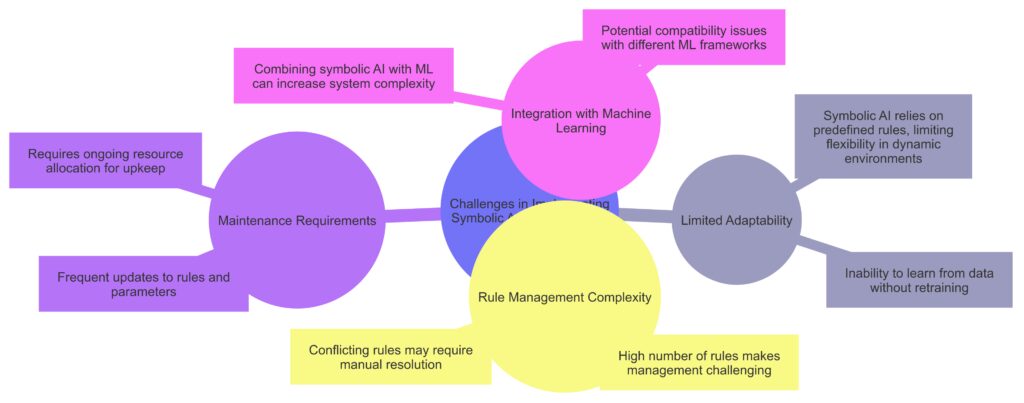
Limited Adaptability: Symbolic AI’s reliance on static rules limits its flexibility in dynamic environments and lacks continuous learning.
Rule Management Complexity: Managing a high volume of rules and resolving conflicts can become challenging.
Maintenance Requirements: Frequent rule updates require ongoing resource allocation for upkeep.
Integration with Machine Learning: Integrating symbolic AI with machine learning introduces additional system complexity and compatibility concerns.
Scalability Concerns with Large-Scale Rule Sets
As IoT systems grow in complexity, symbolic AI systems may need to accommodate increasingly extensive rule sets to cover all possible scenarios. For example, in a manufacturing IoT network with multiple devices and processes, defining unique rules for each possible machine state or error can become cumbersome. Managing, scaling, and troubleshooting these rules can require additional resources and expertise, making it challenging to maintain symbolic AI as IoT networks expand.
To address this, organizations need to evaluate the scalability of rule-based models and consider implementing knowledge graphs or modular rule sets that simplify rule management. Some systems may benefit from hybrid AI approaches that allow edge devices to handle simple rule-based tasks and rely on central servers for more complex decisions.
Maintenance and Rule Updates
Symbolic AI systems require frequent updates and maintenance to ensure that rules stay relevant and effective. In an IoT network that’s always evolving—whether in an industrial facility adding new machinery or a smart building upgrading sensors—rules need to be revised to reflect current operational needs. Over time, maintaining these rules can become resource-intensive, especially in industries with frequent changes in equipment or processes.
Organizations using symbolic AI must be prepared to regularly review and update rules, either through automated processes or by employing in-house experts who can quickly adapt rule sets. Failure to do so could lead to errors or reduced effectiveness, as symbolic AI systems rely heavily on the accuracy and relevance of their underlying rule structures.
Integration Complexity with Other AI Systems
Combining symbolic AI with other forms of AI, such as machine learning, can create integration challenges. While hybrid AI approaches offer significant benefits, aligning rule-based logic with the probabilistic nature of machine learning requires careful design and testing. Symbolic AI’s rigid structure can sometimes clash with the fluid, pattern-recognition capabilities of machine learning models, making it difficult to create a cohesive, integrated system.
To avoid integration issues, developers should define clear boundaries for each AI type within the system, assigning tasks that best fit symbolic AI’s rule-based nature to edge devices and reserving more complex or adaptive tasks for machine learning components. This division of roles helps avoid conflicts and ensures both AI types operate optimally within the IoT ecosystem.
Future of Symbolic AI in Edge IoT Systems
Combining Symbolic AI with Federated Learning
Federated learning allows edge devices to train models locally and share insights with a central system without sharing raw data, enhancing both privacy and efficiency. By combining symbolic AI with federated learning, edge devices can benefit from the rule-based efficiency of symbolic AI while still adapting to new patterns and trends learned by similar devices.
For example, a network of health-monitoring wearables can use symbolic AI to monitor for threshold-based alerts while federated learning aggregates insights on less critical trends, such as activity patterns. This combination supports a responsive and privacy-focused IoT system where symbolic AI handles real-time tasks, and federated learning aids continuous improvement across devices.
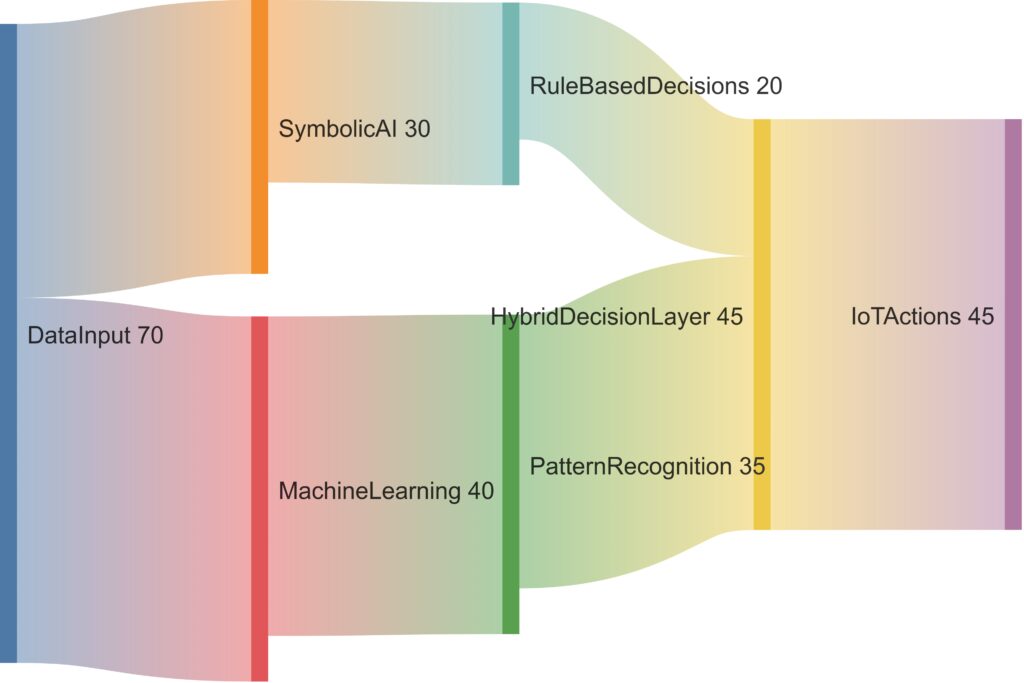
Data Input: Feeds into both Symbolic AI and Machine Learning branches.
Symbolic AI: Processes rule-based decisions based on predefined conditions.
Machine Learning: Handles pattern recognition by analyzing data for trends and anomalies.
Hybrid Decision Layer: Merges insights from both branches to inform efficient, responsive IoT actions.
This setup illustrates how combining rule-based and pattern-recognition approaches creates robust and adaptive responses in IoT systems.
Enhancing Edge Autonomy with Knowledge Graphs
Knowledge graphs are set to play a more prominent role in extending the contextual understanding of symbolic AI systems at the edge. By building out interconnected data points that represent the relationships between different entities and conditions, knowledge graphs allow edge devices to make more context-aware decisions without relying on cloud-based resources.
In a smart transportation network, for example, a knowledge graph can represent relationships between vehicles, routes, and traffic conditions, enabling symbolic AI on each device to make informed decisions based on its position within the network. This approach could improve the autonomy and intelligence of edge devices by giving them a deeper contextual understanding of their environment.
Adoption in Low-Power, Remote IoT Systems
As IoT expands into fields like agriculture, environmental monitoring, and wildlife conservation, low-power, remote IoT devices are increasingly common. Symbolic AI, with its minimal computational requirements, is highly compatible with these applications, enabling intelligent functions that consume minimal power.
In these remote systems, symbolic AI could automate responses to environmental triggers like soil moisture levels, water quality, or animal movement, all while maximizing battery life. This efficiency makes symbolic AI a promising technology for widespread deployment in sustainable IoT applications that require minimal human intervention.

Early Adoption (2024-2025): Focuses on initial rule-based decision-making and basic automations.
Expansion (2026-2027): Optimizes rule management for efficiency and improves response times for real-time applications.
Advanced Integration (2028-2029): Introduces Federated Learning for privacy-preserving insights and Knowledge Graphs for enhanced contextual understanding.
Future Capabilities (2030+): Targets full autonomy in decision-making, interconnected IoT networks with symbolic AI, and expanded applications across sectors like healthcare, smart cities, and industrial IoT.
This progression illustrates the evolving capabilities of symbolic AI as it integrates with advanced technologies to enhance IoT functionality.
Symbolic AI in AIoT (Artificial Intelligence of Things) Evolution
The AIoT movement, where AI powers IoT devices to create intelligent, autonomous systems, is likely to see increasing use of symbolic AI for its cost-effective and transparent nature. As AIoT evolves, symbolic AI could become a central component of systems where explainability, efficiency, and reliability are critical, such as in healthcare, autonomous vehicles, and critical infrastructure.
For example, autonomous drones in disaster response could use symbolic AI to quickly assess and prioritize tasks like searching for victims or delivering supplies. These actions could be driven by symbolic rules to ensure the drone’s response aligns with rescue priorities while maintaining resource efficiency. In this way, symbolic AI is poised to play a critical role in the growth of intelligent IoT by offering a balanced approach to autonomy and resource conservation.
Supporting Regulations and Compliance in IoT
With regulatory pressures increasing in areas like data security, healthcare, and automotive safety, symbolic AI’s transparent decision-making can support compliance efforts by providing easily auditable processes. Because symbolic AI bases its actions on clear rules, it becomes easier for organizations to demonstrate compliance with regulations, making it an ideal choice for industries with strict oversight.
As governments and regulatory bodies continue to impose new standards for AI and IoT, symbolic AI’s rule-based transparency will become increasingly attractive. For instance, in medical devices, where safety and accuracy are paramount, symbolic AI enables developers to build compliance-friendly IoT systems that can pass regulatory scrutiny and gain the trust of users and governing bodies.
By leveraging symbolic AI, organizations can power IoT edge devices with intelligent, rule-based decision-making that prioritizes efficiency, autonomy, and transparency—paving the way for a more sustainable and responsible IoT future.
Conclusion: The Role of Symbolic AI in the Future of IoT
As IoT networks continue to expand, so does the need for efficient, autonomous, and sustainable intelligence across edge devices. Symbolic AI offers a valuable solution to the challenges faced by IoT systems, especially when computational resources, power, and connectivity are limited. By allowing IoT devices to make intelligent, rule-based decisions locally, symbolic AI supports faster response times, lower power consumption, and improved reliability.
Symbolic AI’s transparency and explainability further make it a strong fit for industries that require auditability and adherence to regulatory standards. In fields like healthcare, smart cities, agriculture, and industrial automation, symbolic AI not only enhances operational efficiency but also enables IoT systems to act safely and consistently within established rules.
As symbolic AI integrates with emerging technologies such as federated learning and knowledge graphs, it will likely see growing adoption in the AIoT landscape. This evolution will provide IoT developers with powerful, contextually aware solutions that enhance the autonomy and intelligence of edge devices without requiring extensive computational power.
In a world increasingly reliant on real-time data and automation, symbolic AI presents a pathway to scalable, energy-efficient IoT systems that deliver intelligence and responsiveness precisely where they are needed—at the edge. The continued development of symbolic AI in edge computing promises to drive innovation across diverse industries, redefining what IoT devices are capable of achieving in an efficient and sustainable way.
FAQs
Can symbolic AI operate without internet connectivity?
Yes, symbolic AI is well-suited for offline operation because it doesn’t require constant data updates from the cloud. Since it operates based on predefined rules, symbolic AI allows IoT devices to function autonomously even in areas with limited or intermittent connectivity, such as remote environments or rural locations.
What are the main limitations of symbolic AI for edge devices?
One main limitation of symbolic AI is its rigidity—it relies on predefined rules, making it less adaptable to unforeseen scenarios or highly variable environments. Additionally, as the complexity of the IoT system grows, symbolic AI may require an increasing number of rules, which can become difficult to manage. This can make it less suitable for applications where flexibility and adaptation to new data are critical.
How does symbolic AI support regulatory compliance?
Symbolic AI’s rule-based approach is transparent and interpretable, making it easier to audit and comply with regulatory requirements. In sectors like healthcare, finance, or industrial IoT, where decision-making needs to be clear and explainable, symbolic AI provides a compliant-friendly framework. Its decisions are traceable and based on logical rules, which can be readily reviewed to meet compliance standards.
Can symbolic AI work with machine learning in IoT systems?
Yes, symbolic AI can be combined with machine learning to create hybrid systems. In a hybrid setup, symbolic AI can manage straightforward, rule-based tasks, while machine learning handles more complex data analysis and pattern recognition. For instance, in a smart factory, symbolic AI can manage routine tasks like equipment monitoring, while machine learning algorithms predict future maintenance needs. This combination provides efficient and adaptive intelligence across IoT systems.
How does symbolic AI reduce power consumption in IoT devices?
Symbolic AI is inherently resource-efficient because it operates on simple, rule-based logic rather than computationally intense algorithms. Since edge devices often have limited processing power and battery life, symbolic AI’s low-power requirements allow these devices to make intelligent decisions without draining power quickly. This efficiency is especially useful in remote or battery-powered IoT devices, where conserving energy is crucial for long-term operation.
What types of industries benefit most from symbolic AI in IoT?
Industries that require real-time decision-making on low-power devices greatly benefit from symbolic AI in IoT. For example, healthcare uses symbolic AI in wearable devices to monitor patient metrics and trigger alerts without needing cloud support. Manufacturing leverages symbolic AI to monitor equipment health and send alerts on-site, improving safety and efficiency. In smart agriculture, symbolic AI helps manage irrigation and monitor soil conditions in remote environments with minimal connectivity and power.
Is symbolic AI reliable for critical applications?
Yes, symbolic AI is highly reliable for mission-critical applications that require precise, rule-based responses. Because it follows explicit rules, it provides predictable and consistent results, which is ideal for applications where reliability is essential, such as emergency response systems, industrial monitoring, and healthcare devices. However, for scenarios that require adaptability to highly variable conditions, combining symbolic AI with other AI types may improve reliability.
How does symbolic AI improve security on edge devices?
Symbolic AI enhances security on edge devices by enabling them to detect and respond to rule-based anomalies locally, without relying on centralized servers. This decentralized approach reduces the risk of potential vulnerabilities associated with cloud dependence and network latency. For example, edge devices can use symbolic AI to monitor for unusual activity, like unexpected access attempts, and trigger immediate local responses or alerts, which helps secure IoT networks from breaches.

Security Incident Detected: Initiates response.
Anomaly Detection: Identifies unusual activity locally.
Local Rule-Based Analysis: Assesses the incident using predefined security rules.
Automated Response: Responds to threats autonomously when possible.
Notify Central Server: Sends alerts if further action is required.
Escalate for Further Analysis: Engages additional security measures if needed.
This approach allows for efficient, immediate responses while providing options for escalation and centralized alerting when necessary.
Can symbolic AI help reduce latency in IoT systems?
Yes, symbolic AI significantly reduces latency by processing decisions locally on the device. Unlike data-driven AI models that rely on cloud processing, symbolic AI allows edge devices to respond instantly, making it ideal for time-sensitive IoT applications like real-time monitoring, emergency response, and automated control systems. By eliminating the need for constant data transfer, symbolic AI ensures that devices act immediately on local inputs.
How does symbolic AI handle complex decision-making on edge devices?
While symbolic AI is well-suited to straightforward decision-making based on predefined rules, it can also handle moderately complex decision-making by incorporating knowledge graphs and hierarchical rule sets. Knowledge graphs allow edge devices to understand relationships and contexts, enabling them to make more informed decisions without central processing. However, for highly complex tasks that require pattern recognition, combining symbolic AI with other AI models can improve functionality.
Are there any privacy advantages to using symbolic AI in IoT?
Symbolic AI supports privacy-focused IoT systems by allowing data processing to happen locally on devices. Because decisions are made based on predefined rules, data often doesn’t need to be transferred to cloud servers for analysis, reducing the risk of data exposure and enhancing privacy. This local processing is particularly beneficial for applications involving sensitive data, such as healthcare monitoring or smart home systems, where privacy is a top priority.
How can symbolic AI be adapted as IoT systems evolve?
As IoT systems evolve, symbolic AI can be updated with new rules and relationships to adapt to changing needs and conditions. This flexibility allows symbolic AI to remain relevant, though it requires routine updates to ensure its rules remain accurate. In cases where systems become too complex for rule-based updates alone, integrating symbolic AI with machine learning or other adaptive models can enhance the system’s ability to handle new scenarios.
What is the cost of implementing symbolic AI on edge devices?
Implementing symbolic AI is often cost-effective because it doesn’t require high-performance hardware or extensive data for training. It can be deployed on existing IoT devices with basic processing capabilities, keeping costs low. Additionally, symbolic AI’s efficient, low-power design means reduced operational expenses over time, especially in large-scale IoT deployments where thousands of edge devices need to operate autonomously.
Resources
Online Courses and Lectures
- Coursera: “Introduction to Artificial Intelligence (AI)”
Offered by IBM, this course provides foundational knowledge in AI, covering rule-based systems, logic programming, and symbolic reasoning—key concepts for applying symbolic AI to IoT devices. Visit Coursera - edX: “Artificial Intelligence for Real-World Applications”
This course, by the University of Adelaide, includes modules on symbolic and rule-based AI for embedded systems and edge devices. It’s designed for practical application, covering techniques suitable for IoT environments. Visit edX - Udacity: “Edge AI for IoT”
This Nanodegree program focuses on AI applications in IoT, including edge-based reasoning and efficient AI solutions for low-compute environments. The course explores both symbolic AI and other models. Visit Udacity
Websites and Blogs
- Towards Data Science: Symbolic AI for IoT
Towards Data Science regularly publishes articles on symbolic AI, rule-based systems, and IoT applications. The blog is accessible and often includes tutorials for building symbolic AI models for edge devices. Visit Towards Data Science - MIT Technology Review – Artificial Intelligence Section
MIT Technology Review covers the latest developments in AI, including insights into symbolic AI and edge computing. It’s a good resource for understanding how symbolic AI is evolving in the IoT space. Visit MIT Technology Review - Edge AI and Vision Alliance Blog
This site provides information on various AI applications in edge computing, with specific discussions on efficient AI models, including symbolic AI and knowledge graphs, for low-power IoT devices. Visit Edge AI and Vision Alliance
Industry Reports and White Papers
- “The Role of Symbolic AI in IoT Edge Computing” by Gartner
Gartner’s report examines how symbolic AI is reshaping IoT, with sections on edge devices, knowledge management, and symbolic AI’s role in real-time decision-making. - “Hybrid AI Models in Edge Computing for IoT Systems” by McKinsey & Company
This white paper explores hybrid approaches, including symbolic AI’s integration with machine learning for IoT. It discusses the trade-offs and benefits of symbolic reasoning on edge devices. - “Scaling IoT Intelligence: Symbolic AI as a Sustainable Solution” by Accenture
This report outlines symbolic AI’s advantages in scalability, energy efficiency, and transparency, making a strong case for its use in large-scale IoT deployments.